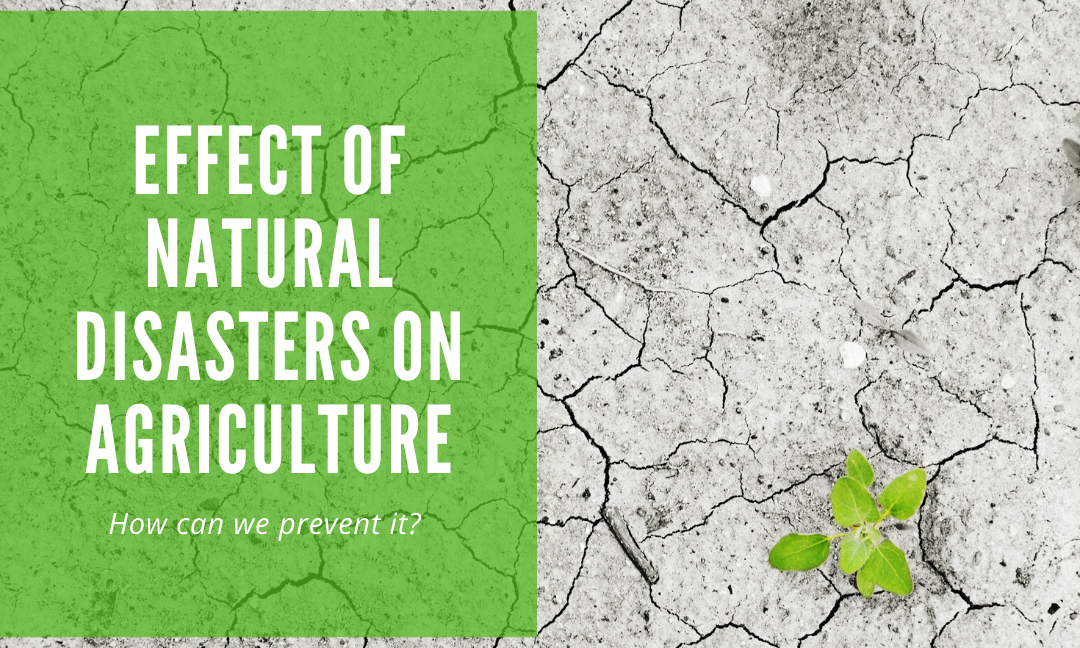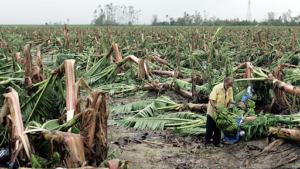Author: Juiee
Editor: Connor Fraser
Graphic Designer: Rayna Almas
Publisher: Jumana Ismail
Introduction
Imagine a world with no food production; impossible, right? This is because agriculture is a vital part of our living. Agricultural food productions take place all over the world 24/7; harvesting, yielding, importing, and exporting. However, there is no such thing as a “perfect” growing season. Many factors disrupt the chain of food yielding and production. One of the biggest factors is natural disasters.
Some examples of natural disasters include earthquakes, tsunamis, storms, wildfires, floods, droughts, etc. Natural disasters are caused by the natural processes of the Earth, and are out of mankind’s control. And so — by name — natural disasters cause lots of damage and destruction! Let’s get into the details as to how natural disasters affect agriculture.
Damage, Destruction, and Disaster
In developing countries, such as Canada, the agriculture sector absorbs 23% of total damage and losses from natural disasters every year! In fact, $116 billion were lost in agricultural production in developing countries between 2005-2014. Who knows how much would have been lost in the entire world! Can you guesstimate? Share your answer in the comments section below.
Now, how does this affect the agricultural industry? Well, these disasters can destroy critical agricultural assets like infrastructure, production cycles, trade flows, and jobs. Many worldwide rely on farming to make ends meet. However, if there was no food to harvest, there would be no money (in certain jobs). In addition, food security would be at risk, which would cause additional disruptions and imbalance throughout value chains such as scheduled imports and exports. This, in turn, could potentially affect overall economic growth of a society as agriculture accounts for a large share of gross domestic product (GDP) and employment.
Do you know which type of natural disaster causes the most damage? Disasters which occur due to the climate are mainly the ones to blame, such as droughts and floods! In fact, losses from climate-related disasters between 2006 and 2016 accounted for 26% of all damages. Droughts in particular are one of the leading natural disasters since they account for around 19% of all agricultural losses. In fact, up to 20% of potential agricultural production could be lost due to severe drought episodes!

All About Drought
Droughts are climate-related natural disasters. They occur when there is little to no precipitation for a long period of time in an area. Lack of precipitation can lessen crop yield which has a huge effect on agriculture.
A latest and real life local example of this in 2021 was in Alberta, Canada.
The northern part of Alberta (north of Calgary) was still receiving some moisture throughout the year hence crops were able to be harvested in the summer. However, the southern part of Alberta (south of Calgary) was able to yield little to no crops due to the harsh heatwaves and lack of rainfall this summer. Hence, there were issues regarding production, marketing, as well as contracts made to sell the crops! In fact, President of the Alberta Federation of Agriculture Lynn Jacobson made a statement saying “…. running at the trouble of supplying or buying their contracts out, and there’s quite an issue basically over some of the administration fees and interest charges that have been charged by some of the grain companies. So that’s a big issue for people.”

A corn plant that was struggling to survive this week in a drought-stricken farm field near Shawneetown, Ill
With that said, there have been predictions made that another dry year is coming up as there is an insufficient amount of moisture in crops’ soil to yield and sell them for good money (profit). However, there are thoughts and discussions of constructing an expansion of irrigation districts in Alberta. Although this is an excellent idea, it’s all dependent on the amount of precipitation throughout 2022.
Any solution?
So, with all these risks at place, is there any solution? The United Nations is currently working on Disaster Risk Reduction (DRR) strategies for nations, especially those who are prone to such natural disasters.
But what is the cause of these limited precipitation, heatwave, and drought patterns? Climate change!
According to WeForum.org, “Heatwaves and droughts will pose the greatest threat in the next decade, as temperatures continue to rise due to heat-trapping gasses.” These ‘heat-trapping gasses’ are greenhouse gasses which are caused primarily due to climate change. The greenhouse gas effect absorbs and holds heat; altering the water cycle. This results in soils losing their moisture and becoming more hot which causes drought. Droughts have been and are occurring all over the globe, especially in South Africa.
Having said that, is there any prevention of climate change? Not exactly, but there are numerous ways we can try to control this issue. This comes first with education. Many people are simply not aware of this hot issue. Hence why awareness is crucial to take steps in improving this issue. In fact, I am currently working on a project that is dedicated to advocating and improving on the global issue of climate change! My group mates and I are working on bringing more awareness of this to all students in our school by creating and leading a climate club as well as taking actions to improve on this global issue by planting trees on school grounds! Our end goal is to inspire others in making continuous change and improvement towards climate change. Although there is no direct solution to climate change, there are many ways we can all contribute to improving this issue.
 However, there IS a potential solution to conserving crops in the situation of a drought! 2016 Google Science Fair winner Kiara Nirghin of South Africa devised a solution to this problem! At the age of 16, Kiara submitted her invention of a super absorbent polymer (SAP) of which the crop could be planted and grown in. The SAP was made of organic and biodegradable materials: orange peels and avocado skins. When left in the sun, the peels and skins react and bond together, hence forming the polymer. This polymer can store and hold reserves of water hundreds of times its own weight.
However, there IS a potential solution to conserving crops in the situation of a drought! 2016 Google Science Fair winner Kiara Nirghin of South Africa devised a solution to this problem! At the age of 16, Kiara submitted her invention of a super absorbent polymer (SAP) of which the crop could be planted and grown in. The SAP was made of organic and biodegradable materials: orange peels and avocado skins. When left in the sun, the peels and skins react and bond together, hence forming the polymer. This polymer can store and hold reserves of water hundreds of times its own weight.
Therefore, farmers can still maintain their crops in drought when the conditions are very dry since the crop solely relies on the water stored in the polymer it’s planted in. On top of that, this invention is extremely beneficial as it’s composed of low-cost, recyclable, biodegradable, and very accessible products! Do you believe this invention is a solution to the effect of drought? Do you know any other solutions? Let me know your thoughts in the comments!
Conclusion
Having said all this, there is definitely hope for solving this problem. Yes, we aren’t able to control the acts of Mother Nature, but we are able to work on protecting and conserving crops and agriculture as much as possible! As Kiara Nirghin said, “dreams don’t work unless you do”. If we can all come together and work on not only improving on the issue of agriculture production in drought but also climate change, our globe will become a much more sustainable place! All it takes is you to make that first step.
Sources
- https://www.fao.org/3/i7279e/i7279e.pdf
- https://www.undrr.org/publication/gar-special-report-drought-2021
- https://www.weforum.org/agenda/2020/10/natural-disasters-tsunamis-droughts-floods/
- https://www.amnh.org/exhibitions/climate-change/changing-land
- https://lethbridgeherald.com/news/lethbridge-news/2021/12/29/agriculture-sector-seared-by-drought-in-2021/
- https://www.cnn.com/2016/08/09/africa/orange-drought-kiara-nirghin/index.html
- https://www.csis.org/analysis/case-disaster-smart-agriculture-2017-reflections
- https://www.npr.org/sections/thetwo-way/2012/07/18/156981232/drought-disasters-declared-in-more-counties-1-297-affected-so-far
- https://leadingladiesafrica.org/meet-16-year-old-kiara-nirghin-south-african-innovator-google-science-fair-winner/



Trackbacks/Pingbacks